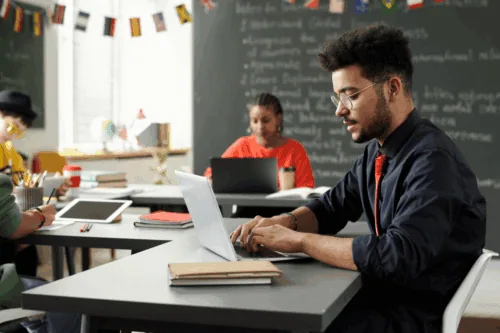Welcome to your guide on understanding and achieving equity in education! If you’re stepping into the job market or considering a career in education, understanding the principles of educational equity is crucial. This guide provides comprehensive insights into educational equity, highlighting practical examples, challenges, and strategies for fostering inclusive educational environments.
Whether you’re an entry-level job seeker eager to make informed decisions about potential career paths or someone interested in educational reforms, this guide will equip you with the knowledge and tools needed to advocate for equity in education. Dive in to learn how equitable practices can transform educational settings and create opportunities for everyone.
Understanding Equity in Education
Equity in education focuses on ensuring that every student has access to the resources, opportunities, and support they need to achieve their fullest potential.
Key Components of Educational Equity
Educational equity involves several crucial elements:
- Access: All students, irrespective of their background, should have access to quality educational resources.
- Inclusion: Creating an environment where all students feel welcomed, respected, and valued.
- Support: Providing additional help to those who need it, whether through tutoring, counseling, or specialized programs.
This approach also means actively working to remove barriers to student success. These could be economic, cultural, or language barriers that prevent equal participation in educational opportunities.
Why Equity Matters
Advocating for equity in education isn’t just about fairness; it’s also about enhancing societal well-being. Schools prioritizing equity foster a community of learners who feel seen and supported. This can lead to higher levels of academic achievement and better preparation for a diverse workforce.
Additionally, embracing diverse inclusion in education models good societal behavior and raises awareness about global and community issues.
Equity in education is essential for dismantling systemic barriers and provides every student with the tools to succeed. For a more in-depth discussion, you might want to look into resources from reputable educational bodies. A resourceful link would be the National Education Association’s page on equity.
Equity in Education Examples: Case Studies
Here are several case studies highlighting how schools and districts have successfully implemented equity-driven initiatives to illustrate equity in education in action.
Case Study 1: Culturally Responsive Curriculum
One urban school district recognized the need to align its curriculum more closely with the diverse backgrounds of its students. This led to the development of a culturally responsive curriculum that incorporated:
- Multi-language instruction materials,
- Curricula that reflect diverse cultural perspectives and
- Training teachers to handle cultural differences sensitively and effectively.
This initiative not only improved student engagement but also boosted academic achievements among minority groups significantly.
Case Study 2: Addressing Socio-economic Disparities
A high school in a low-income area established a program targeting resource accessibility. The program included:
- Providing students with free digital devices and broadband access,
- After-school tutoring programs focused on closing the knowledge gap,
- Partnerships with local businesses to offer mentorship and internships.
These efforts led to an improved graduation rate and college attendance figures that exceeded the national average for similar socio-economic areas.
Both cases highlight practical equity applications and demonstrate measurable outcomes resulting from tailored needs-based educational strategies. For more insights, educators can refer to the U.S. Department of Education’s Equity and Inclusion initiatives.
In the following section, we will discuss various strategies that educational institutions can use to promote equity effectively within their environment.
Strategies to Promote Equity in Schools
Fostering equity in education requires a multi-faceted approach. Here are effective strategies that schools can adopt:
Training Educators on Implicit Bias
All teachers carry inherent biases that can influence their teaching styles and decisions. Schools can help educators recognize and mitigate these biases by providing regular training on implicit bias, ensuring equitable treatment for all students.
Inclusive Policy Making
Involving diverse stakeholders in policy development—including parents, students, community members, and educators from diverse backgrounds—helps create more inclusive school policies.
Equitable Resource Allocation
Ensuring that resources are distributed based on the needs of the students rather than uniformly across the board is crucial. This might mean more funding for schools in underprivileged areas or additional support for students with disabilities.
Comprehensive Support Systems
Implementing comprehensive support systems can significantly impact student success. This includes:
- Mental health services,
- Academic counseling, and
- Career guidance programs.
Additionally, schools can use technology to level the playing field. For instance, enabling learning through platforms accommodating different learning styles broadens access and participation. Learning Forward’s discussion on equity through technology provides further insights.
When implemented thoughtfully, these strategies can steer school practices towards greater equity, enabling all students to thrive.
Benefits of Equity in Educational Settings
Adopting equity in education not only supports individual students but also enhances the educational system as a whole. Here are the key benefits:
Improved Academic Performance
Equitable education systems are designed to meet individual needs, leading to an overall improvement in academic performance. Students receive the specific support they require, often resulting in higher engagement and better grades.
Reduced Dropout Rates
Equity-focused schools provide the necessary resources and support to keep students on track toward graduation. When students feel supported, and their learning needs are met, they are less likely to drop out.
Enhanced Cultural Competence
Schools that emphasize equity help students understand and value diversity. This education fosters cultural competency, preparing students to function and succeed in a diverse global society.
Increase in College Admissions and Success
Equitable educational practices contribute to a higher college admissions rate among underrepresented groups. Supportive preparation and resources ensure that more students are college-ready upon graduation.
Moreover, equity’s positive impact extends beyond the classroom. For insightful success stories, the U.S. Department of Education’s reports on educational access and success provide comprehensive data and examples of effective equity implementation.
By focusing on equitable practices, educational institutions create an environment where all students can succeed and contribute meaningfully to society.
Challenges in Achieving Educational Equity
Achieving equity in education is vital, yet several challenges often impede progress. Below are some major hurdles:
Funding Disparities
Despite attempts to balance resources, funding disparities continue to exist between schools in affluent and low-income areas. This gap affects the quality of facilities, teaching materials, and student extracurricular opportunities.
Resistance to Change
Implementing new policies and practices that promote equity can meet resistance from various stakeholders. This includes staff, parents, and even community members who may not immediately see the benefits of such changes.
Lack of Awareness
Not everyone understands what educational equity involves or why it is necessary. Raising awareness and providing education on this topic is crucial for garnering support.
Diverse Student Needs
Every student is unique, making it challenging to effectively address all their needs. Tailoring education to fit diverse needs requires significant time, effort, and innovation.
Schools need support from all stakeholders to overcome these challenges. Engaging the community, securing appropriate funding, and fostering an inclusive culture are essential steps. For more detailed guidelines, educational leaders can access Office for Civil Rights resources.
Addressing these challenges head-on allows schools to build a more equitable educational environment where all students thrive.
Supporting Materials: Resources and Tools
To further equity in education, various resources and tools are available to support educators and institutions. Here’s a look at some key materials:
Educational Technologies
Technology can bridge gaps in learning and access. Online platforms and digital tools offer personalized learning experiences necessary for addressing individual student needs.
Professional Development Programs
Ongoing training programs for teachers and administrators are crucial. These programs focus on equity principles, culturally responsive teaching, and effective strategies to manage diverse classrooms.
Community Partnership Programs
Linking with local businesses, nonprofits, and higher education institutions can provide students with additional resources, such as internships, scholarships, and after-school programs.
Policy Guides and Frameworks
Frameworks designed by educational leaders can help schools implement structured equity practices. These guides often include actionable steps and benchmarks for success.
For educators looking to deepen their understanding and improve their practices, Teaching Tolerance offers a wealth of free materials geared toward nurturing an equitable learning environment.
These tools and partnerships play pivotal roles in promoting equity and ensuring every student has the opportunity to succeed in their educational journey.
Community Involvement in Promoting Equity
Fostering equity in education also involves active community participation. Community members play a crucial role in advocating for and sustaining equitable practices.
Engaging Parents and Families
Parents and families are vital stakeholders in the education system. Schools can facilitate workshops and informational sessions to educate them on equity and inclusion, empowering them to advocate for their children’s needs.
Local Businesses and Corporate Partnerships
Collaborations with local businesses can provide students with internship and apprenticeship opportunities. These partnerships often bring additional resources to enhance educational programs and student learning experiences.
Volunteer Programs
Community volunteers can support schools by offering tutoring, mentoring, or even administrative assistance. Engaging volunteers from diverse backgrounds can also provide students with role models and mentors who reflect their own diversity.
Community Advocacy Groups
Working with advocacy groups can help push for policy changes at higher levels of governance, ensuring that equity remains a central theme in educational reform. Organizations like the ACLU offer resources and support for those seeking educational advocacy.
Community involvement is essential for creating a sustainable environment that supports equity in education, and drives change within schools and throughout entire neighborhoods and regions.
Future Perspective: Moving Forward with Equity
Looking to the future, the ongoing commitment to equity in education is paramount for developing a society where everyone has a fair opportunity to succeed.
Policy Evolution
Education policies must continuously evolve to address new challenges and disparities as they arise. Including diverse voices in policy, creation helps ensure these adaptations are effective and inclusive.
Technology Integration
As technology advances, leveraging new tools and platforms will be crucial in delivering personalized education that efficiently meets different learning needs.
Global Collaborations
Collaborating with educational institutions worldwide can bring new perspectives and strategies into local education systems, enhancing the global understanding of equity.
Sustained Community Efforts
Community involvement must remain strong for lasting change. Continued engagement, support, and advocacy are the keys to ensuring equity efforts are not just temporary fixes but sustainable improvements.
The journey towards complete equity in education is ongoing. However, each step taken can significantly improve the educational playing field. By committing to these future-oriented strategies, educators and communities can help pave the way for a more equitable educational landscape.
FAQs
What exactly is educational equity?
Educational equity means ensuring every student has access to the resources, opportunities, and support they need to succeed, regardless of their background or personal circumstances.
Why is equity more important than equality in education?
While equality provides the same resources to all students, equity tailors resources to meet the diverse needs of each student, which is crucial for addressing individual challenges and promoting fair outcomes.
How can schools measure educational equity?
Schools can track equity by examining disparities in academic performance, resource allocation, and student satisfaction across different groups, ensuring all students benefit equally from equity in education.
Can technology improve educational equity?
Yes, technology can enhance equity by providing personalized learning experiences and removing barriers to information and resources, especially for students in remote or underserved areas.
What role do parents play in promoting educational equity?
Parents are key advocates for equity. They can push for changes at school and district levels, participate in educational planning, and ensure their children’s needs are met.
How does cultural competence contribute to educational equity?
Cultural competence among educators and students fosters an inclusive atmosphere that respects and values diversity, which is crucial for achieving educational equity.
What strategies can schools use to combat funding disparities?
Schools can advocate for policy changes, seek alternative funding through grants, and collaborate with community partners to pool resources effectively.
Conclusion
Equity in education is essential for creating environments where all students can thrive, irrespective of their background. Educational institutions can make significant strides toward equitable outcomes by implementing personalized strategies, acknowledging diverse needs, and fostering community involvement. However, achieving true educational equity requires ongoing effort, adaptability, and commitment from everyone within the educational ecosystem.
As you push forward in you diversity job search, consider joining Diversity Employment, we champion inclusive hiring and educational practices. Join us in our mission to promote diversity and equity in the workplace and beyond. Together, we can contribute to a more equitable society, starting with the foundational element of education.




